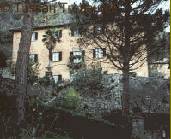![]()

View along
Via dell'Orto toward
San Cristoforo
Cortona Information
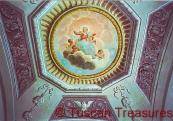
Frescoed dome in Cortona Palazzo
- by school of Pietro
Berrettini (early 1600s)
The Cortona library (Biblioteca del Comune) in the Palazzo Casali has an extensive collection of historic documents, including over 700 manuscripts and 6,000 volumes regarding local history. The Biblioteca is open M-F 09:00-12:00 & 15:00-18:45 and is closed Aug. 1-15.
Market days (typ. 08:00-13:00)
Cortona: Saturday
Terontola: Tuesday
Castiglione del Lago: Wednesday
Camucia: Thursday
Castiglion Fiorentino: Friday
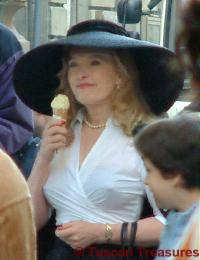
Lindsay Duncan
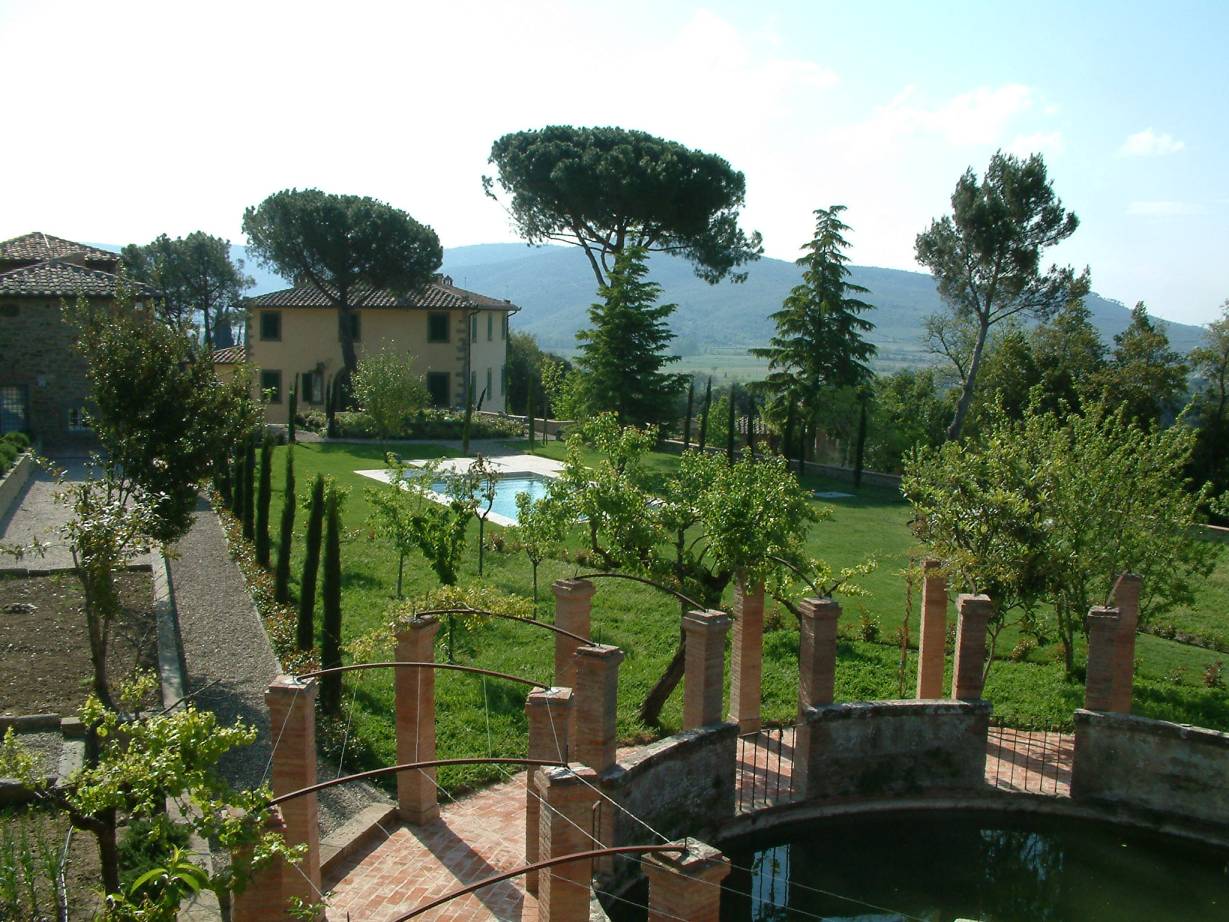
Villa Laura remodel
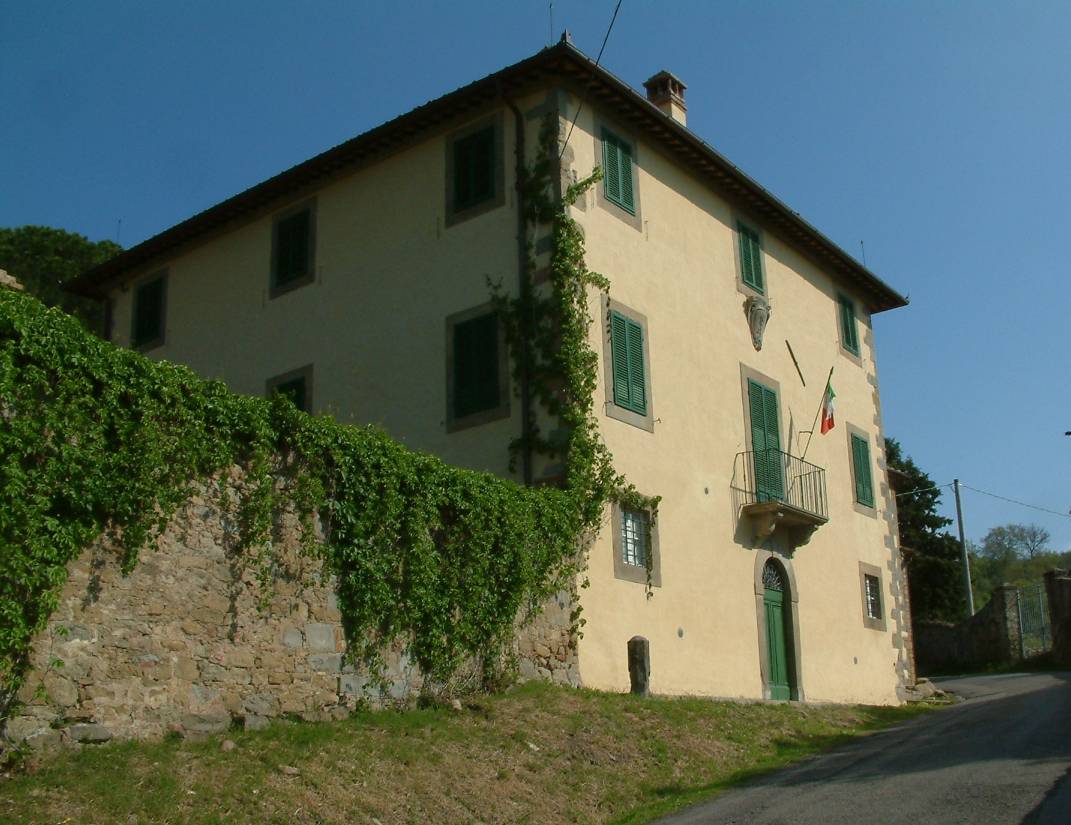
Villa Laura remodel
The charming, steep cobblestone streets and pietra serena buildings of Cortona have been witness to many peoples and changes in power and it has been known by many names - among them Turreno or Turrena, Turno, Corythum by Virgil, Curitu or Corito, Gurton, Kortus, Croton and Cotornia used by Dionysius, Curtonion by Polybus, and finally Cortona by Titus Livius [Tito Livio] ca. 389 BC.
An
important hub for north-south and east-west travel and commerce,
Cortona has changed names and hands many times over the millenia -
from its mythical founding by Dardano at Virgil of Troy's behest (or
as another legend affirms, the Umbrian Tarconte was the founder of
Turreno around 2000 BC); through its reign as one of the twelve
important Etruscan Lucumonies (along with Arezzo, Caere, Chiusi,
Perugia, Rusellae, Tarquinia, Vetulonia, Volsinii, Volterra, and
Vulci); as part of the Roman alliance from ca 400 BC; sacking by the
Aretine Bishop in 1258; as the headquarters of the Aretine Bishop in
the 1300s; sold to the Florentines by the King of Naples in 1411; and
from the mid-1800s as part of the Italian Kingdom. Cortona
flourished particularly during both the Comuni period and under the
direction of the Ranieri-Casali families. The coats-of-arms
(stemmi) of the many noble Cortonese families can be seen in the
courtyard of the Palazzo Casali as well as above the entries of many
buildings in town (e.g. Tommasi).
In addition to the Etruscan walls
(showing repairs from the Roman and Medieval eras) forming an almost
3km perimeter, there are many Medieval (e.g. in via
Iannelli) and Renaissance buildings (e.g. facades of Palazzo
Casali & Palazzo Tommasi).
Church architectures range from the Romanesque/Gothic of Sant'
Agostino through the Renaissance Santa
Maria delle Grazie al Calcinaio and Santa
Maria Nuova to the more modern Santa
Margherita.
Near
Cortona is the convent (i.e. monastery) Le
Celle, founded by Saint
Francis of Assisi, who built the first cell in 1211 (still
preserved with some of his belongings); today the Capuchin monks
occupy it.
Farneta Abbey,
founded ca. 700 AD, is also nearby. The Benedictine order of monks
lived there for about 500 years, from 900-1400 AD. Farneta Abbey is
just off the road between Camucia and Foiano.
Also
close by and visible from Cortona is Lago Trasimeno, site of the
legendary and bloody battle in 217 BC (the Second Punic wars of
218-201 BC) in which Hannibal's troops defeated the Romans led by
Gaius Flaminius Nepote.
The ruins of a large villa with mosaics (ca. Ic BC - Ic. AD, believed to have been the country home of a Roman Emperor) was discovered in nearby Ossaia in 1992. A husband & wife team from the University of Alberta (CAN) head the excavation of this site and a similar one in Sicily.
An Etruscan life-size bronze statue of the orator Aulus Metellus was found in nearby Lago Trasimeno. The statue was dated to the early 1st century BC and is in the collection of the Museo Archeologico in Firenze.
In
Oct. 1992, seven fragments of a bronze Etruscan tablet dating to
III-I century BC were found by Giovanni Ghiottini - supposedly in
the foothills in Camucia. The inscriptions are believed to be records
of sales of properties. These fragments, called the "Tabula cortonensis"
may help in deciphering the Etruscan language. [Note: inaugural
exhibition was July 12, 2001). Based on an anonymous phone call
stating that the fragments were not found where Ghiottini claimed, he
was investigated by various authorities and tried in court; in the
court's judgement he did not receive the reward customary for such a
find. Such legal problems are one of the reasons many finders of
historic items or structures do not report them. In 2005, several new and important tombs were found near that location.
If your schedule permits,
a trip to nearby Arezzo is worthwhile. In addition to the frescoes in
the Basilica di San Francesco by Piero
della Francesca (born in nearby Sansepolcro), its Roman
Amphitheatre and the adjacent Museo Archeologico are well worth
visiting. A bit further afield are Caprese Michelangelo (birthplace
of Michelangelo Buonarroti and location of the Museo Michelangelo), Perugia,
and Assisi.
News:
Villa Laura, the "double" for Bramasole, was sold (
Italian Property as broker) in late 2006 to
the Frederic Thomas Cline
family (of Jacuzzi Family Vineyards & Cline Cellars in Sonoma County, CA). A complete remodel
of the main villa, outbuildings, and surrounding terrain started in early 2007 by G. L. Costruzioni srs of Arezzo. The remodel was principally completed by mid-2010 and majority of the landscaping should be completed within 2011. Villa Laura is available for rental either through Villa Vacations
or directly at Cline Cellars. After completion of this remodel, the Clines purchased a walled property on the slopes between Jovanotti's "Fiorita" and Chiesa Santa Margherita which consist of a house built in the 1800s; a caretaker's cottage; some outbuildings; and
the remains of a convent. The remodel started in late 2011.
After several years of little progress, the escalator to P.za Garibaldi
from the new parking lot below was completed in the Summer of 2006.
The renovated & enlarged Etruscan Museum reopened in September 2005 - among the new exhibits are additional
objects from an imperial Roman villa (occupied from 100 B.C. to about 100 A.D.) at La Tufa near Ossaia; the Sodo tombs; and Hellenistic urns. A recent (2008) addition to the museum is a collection of findings from several tumuli in excellent condition which were found during construction of a road to the new hospital in Fratta.
Steve Thomas of the TV program "This Old House" & crew were in Cortona the week of
May 13, 2002 filming a program re remodel of a villa in the comune of Cortona (near Pergo).Update: Production of the segment was
cancelled when the Belle Arti stopped work due to lack of permits and the owners subsequently
sold the property. The new owner completed the house remodel & landscaping in the Summer of 2006.
A public swimming pool - the Parco Sportivo "G. Favilli" - was built in the area known as Monti del Parterre above the Tennis Club
and just off Viale Passerini (behind Casa di Accoglienza) by the firm A.T.J. (composed of Tennis Club Cortona,
CO.ED.AR S.C.R.L. [Consorzio Edile Artigiano], and Listro S.r.l.) which apparently
will also have a 20 year concession for operation of the facility. The Mayes' contacted the Mayor and
collected signatures in a petition to stop the work purportedly because they fear additional tourist traffic
past Bramasole. Coincidentally, the owners of the villa nearby who had given permission to use
a small nearby plot they owned as parking and construction area rescinded their permission.
An "Open Letter to Frances Mayes"
written by Sig. Enzo Lucente, the pharmacist in town, was published in the Dec. 15, 2004 edition of the local newspaper
L'Etruria. The Mayes' responded shortly thereafter via posters throughout town. Update: Differences were eventually resolved
and work started again on the pool project in Fall 2005. The pool opened in June, 2006 [see info. above].
The new hospital in Fratta S. Caterina, a new modern facility which consolidates services for Cortona, Castiglion Fiorentino,
and Foiano, has opened. The separate hospitals in those cities are being closed. The hospital opening has caused a building boom
in the Fratta area as hospital staff and services move to the area. The previous Ospedale Santa Margherita in Cortona is slated
to be converted into the Liceo Classico & Professionale.
Cortona has previously been a set for of some of the scenes (e.g. Teatro Signorelli) for Roberto Begnini's movie
La Vita è Bella among others.
May 10, 2005: filming began for an Italian biking movie based in
'40s & '50s. Some of the primary areas of Cortona in the film are Teatro Signorelli, Via Nazionale, & the area near
the Convention Center San Agostino.
In September 2002, the first filming of a full-length movie loosely based
on Frances Mayes' book Under the Tuscan Sun began (by Tatiale Films, Inc. of Rome for Disney/Miramax).
It has been described as a "romantic comedy" in which Frances tours Cortona with the "Gay & Away"
tour group [the screenplay [by director Audrey Wells], not atypically, is substantially
different from the book - drawing upon it for the name recognition,
locations, and a few ideas; a viewer of the film who is expecting it
to be a video version documentary of the book will be disappointed].
It is staged in the current day and sets are mostly contemporary with
the exception of some scenes (e.g. the open-air market
in Cortona which is ca. '30s). Filming in Cortona lasted until the end of November '02
and the PG-13 movie was released in theU.S. on September 26, 2003 - to a receptive public which made it the
#2 hit in the box office that weekend taking in almost $10 million! [Note: However, in Disney's 2002
Annual Report there was no mention of the movie and it was not in their 2003 release list!] Originally scheduled
to be in US theaters for only three weeks, demand lengthened its showing to more than eight and thru the weekend of
Nov. 22, 2003 had already grossed more than $US 41 million at the box office. English Video (e.g. USA) was released Feb. 3, 2004.
Diane
Lane ("Unfaithful" & "High Society")
has Frances' role and Raoul
Bova ("Rewind" & "Avenging Angels")
plays "Marcello", an antique dealer (Raoul has a very short appearance in the film); Claudia
Gerini (very attractive & friendly), Valentine
Pelka, the award-winning Lindsay Duncan (attired
elegantly and as somewhat eccentric for the movie), & Sandra Oh
are also in the movie. Audrey Wells ("Guinevere") is
the director; Tom Sternberg ("English Patient" & "La vita è bella")
the producer. There is also a "stand-in" for Bramasole
- Villa Laura (see below), at the
end of the road (Via Gino Severini > Via delle Contesse) which
passes Oasi Neumann, received new makeup for the role and the asphalt road
outside it was temporarily converted into a dirt one ("strada
bianca") for the filming. A temporary Florentine-style fountain, (see
below) made of foam & fiberglass composite, was placed in
Piazza Signorelli for the filming. One scene, filmed at about 3am
Oct. 23, focuses on one of the actresses taking a "dip" in
the fountain, which was filled with warm water for the event. A
nativity scene (see below) was filmed at night
in Piazza della Repubblica with Epsom salts (magnesium sulfate) for
snow. Other locations include Farneta Abbey
(wedding site), Arezzo, Siena, Montepulciano (flag-throwers' scenes),
& Positano.
Operations were based in the Villa Marsili,
with the Ist. S. Margherita across the street providing some parking
and wardrobe storage. Cortona reportedly received about $US 500,000
for the filming in the comune, and it is unknown how much Frances Mayes received
for film rights to her book (It was rumored that she received about $US 2.5
million, but the Mayes' have stated that amount is not true. Further,
"Book Buzz" states that Miramax
obtained the option for "mid-six figures").
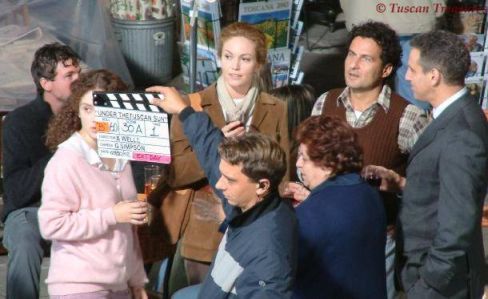
Under the Tuscan Sun filming w/Diane Lane
Piazza Signorelli Oct. 9, 2002
Little was seen of the first-time lead actress, Diane Lane, in Cortona outside the filming. She usually scurried to a scene from her trailer in the Piazza del Duomo when one of the staff told her the coast was clear and dashed off the set between takes. One exception was the weekend of Oct. 12 when her daughter and nanny were visiting and she was seen in town; she generally also dined alone. Other than when the cameras were rolling on the movie set, she was very camera-shy; refusing to allow photos to be taken when asked, saying that cameras made her nervous. She finished shooting in early December and took Delta Flt. #149 from Rome to JFK on Dec. 10 '02. She and husband Josh Brolin visited Cortona in August 2005.
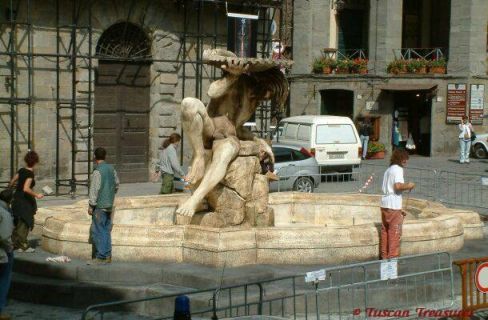
Fountain prop for movie "Under the Tuscan Sun"
Piazza Signorelli Sept. 23, 2002
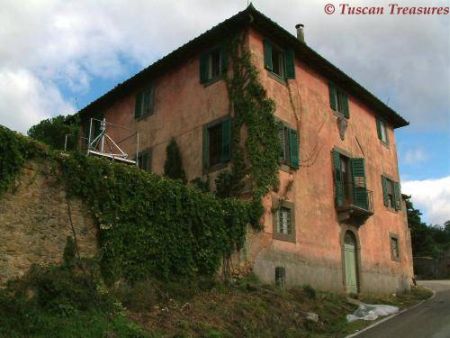
Villa Laura (aka "Bramasole" for the movie)
on Via delle Contesse near Cortona
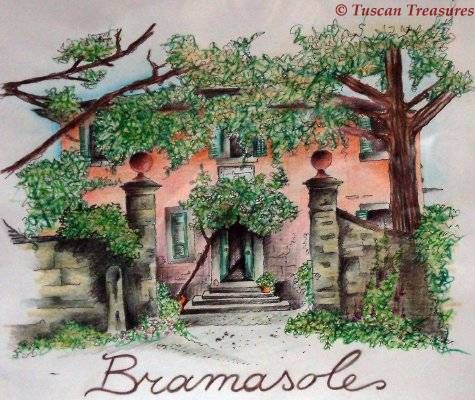
Real estate ad for "Bramasole" in the movie
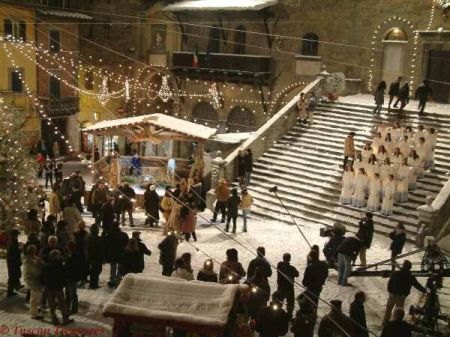
Christmas scene in Piazza della Repubblica
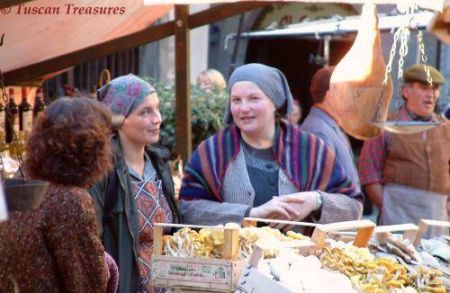
Market scene in Piazza della Repubblica
More links to "Under the Tuscan Sun" Movie info.:
IMDB - Project Genome (HSBR) - Official Movie Site
Note: In mid-May '03, a small advance group appeared to be scouting locations for a new film in Cortona. They seemed to be scouting Cortona & the area for sites.
